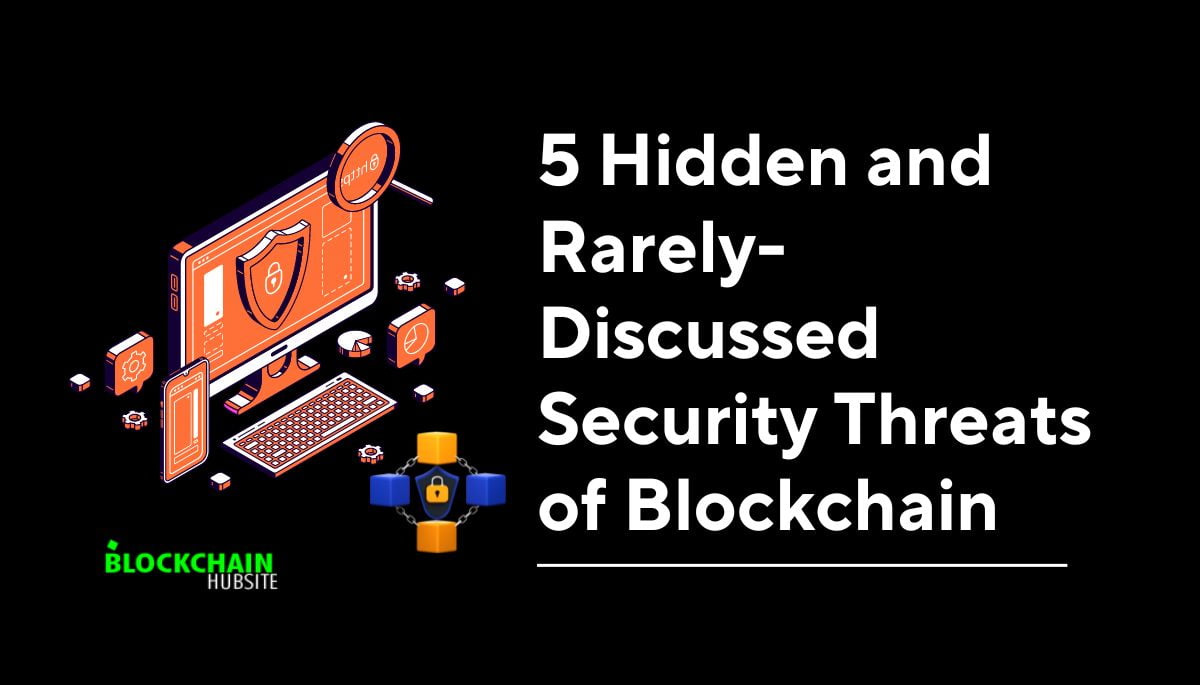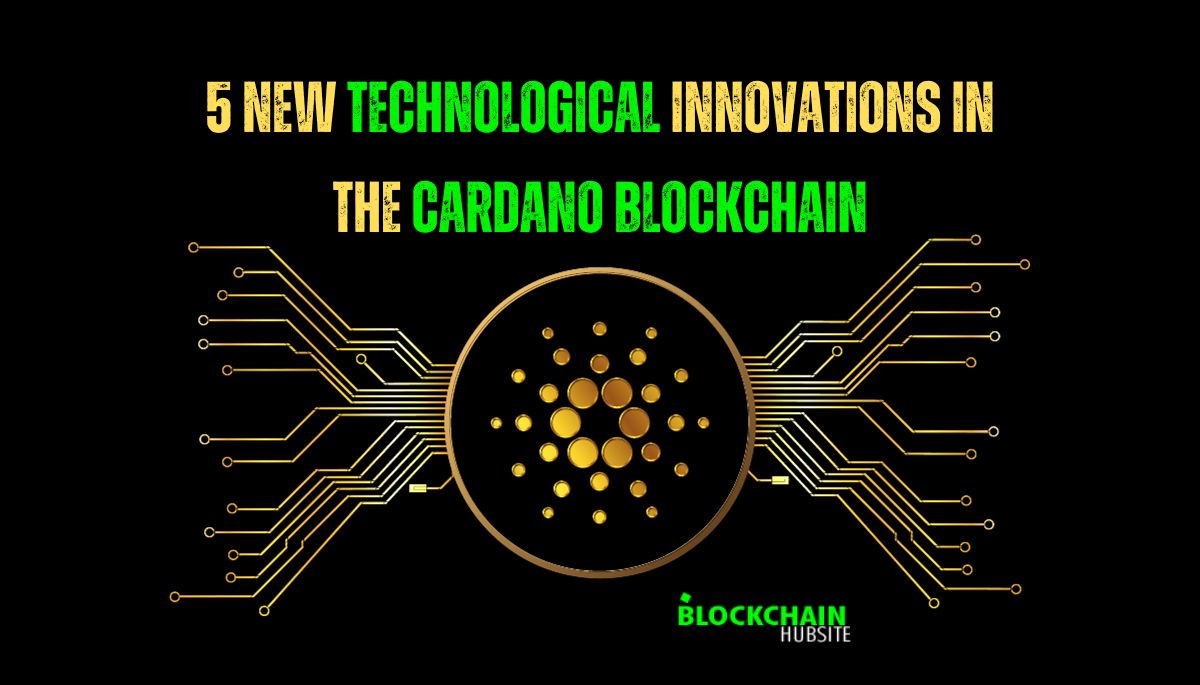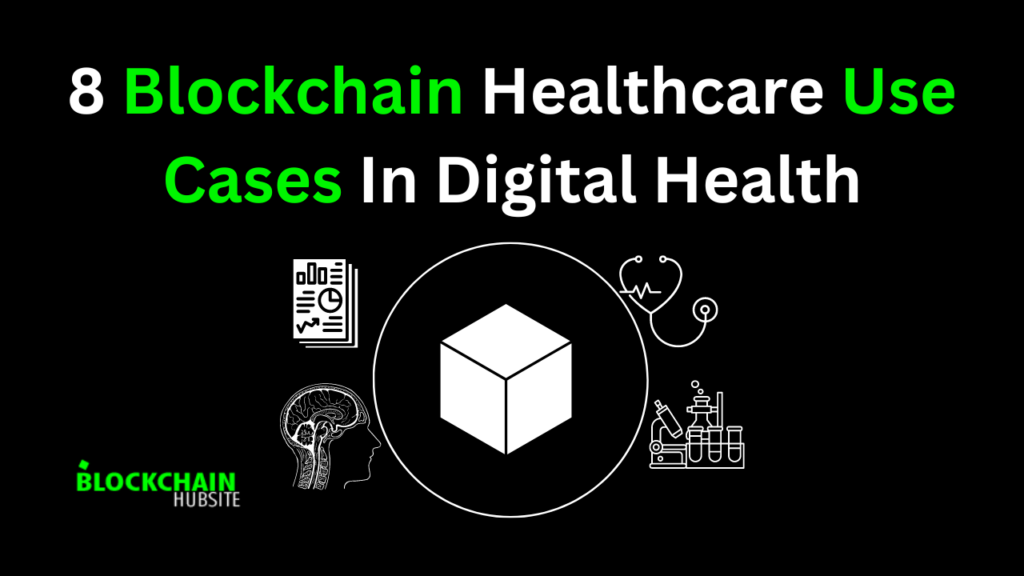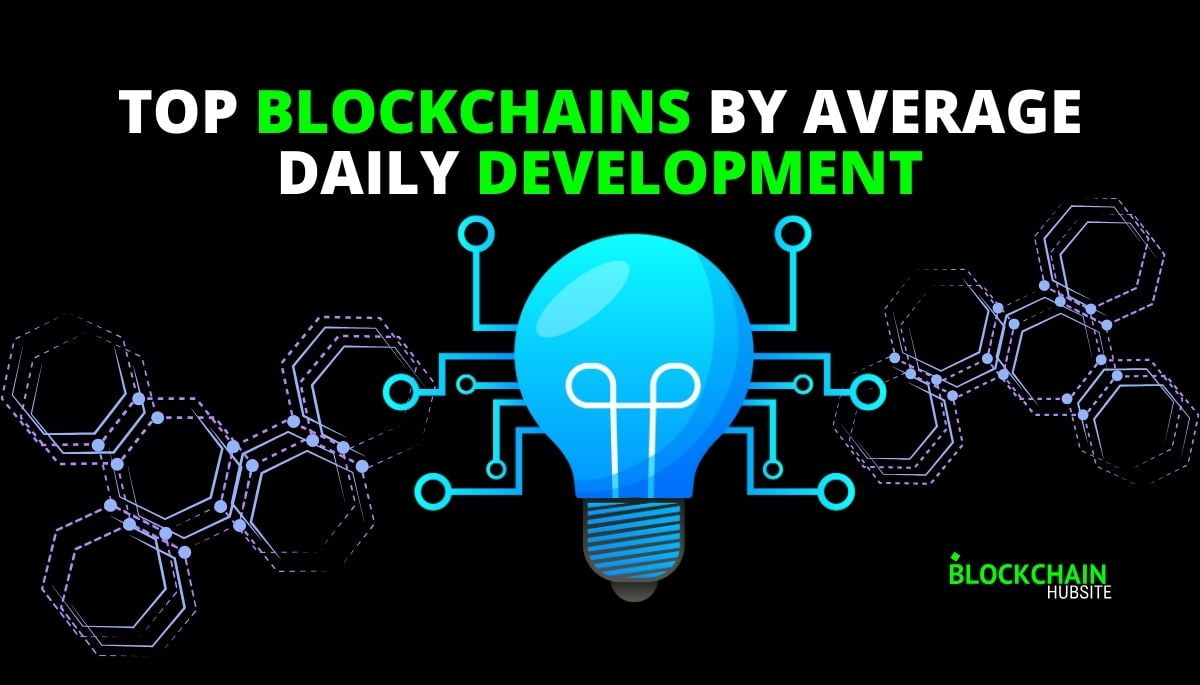
Table of Contents
A select set of blockchains receive significant daily active developer participation, and a dedicated developer community’s collective efforts fuel innovation in the quickly developing world of blockchain technology. Among these, the Top Blockchains By Average Daily Development stand out, with their robust ecosystems and cutting-edge features attracting a vibrant community of developers driving the future of decentralized computing and the broader crypto-sphere.
This article aims to provide insights into the driving forces defining the future of decentralized computing and the broader crypto-sphere by examining these major platforms and delving into their cutting-edge features, governance methods, and real-world applications.
Understanding Daily Active Developers: The Heart of Blockchain Evolution
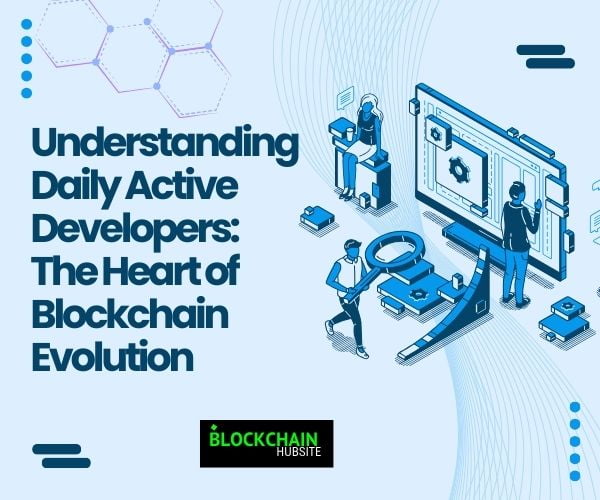
The backbone of any flourishing blockchain ecosystem is the community of developers who work diligently to improve these decentralized networks. These individuals, known as daily active developers, drive the constant innovation and progress observed across the blockchain environment.
Daily active developers are unsung heroes who contribute their talents and experience to blockchain projects’ continuous development, maintenance, and improvement. They help with many important jobs, from writing and improving code to testing, fixing bugs, and adding new features. They must construct the foundational infrastructure and guarantee its efficacy, scalability, and safety.
In addition to their technical expertise, developers who actively participate regularly significantly contribute to their communities by encouraging cooperation and the exchange of knowledge. They collaborate to solve complex problems by sharing ideas and communicating regularly. They periodically research and experiment to find new and better ways of doing things and test the limits of what they think is feasible.
One strong measure of a blockchain’s health and longevity is the number of active developers it has on a daily basis. A strong and rising developer community shows that the project is technically sound and able to attract talented people and build a strong ecosystem. These programmers will be pivotal in the future of decentralized technology, helping to shape the blockchain environment and opening up new possibilities as it develops further.
If you’re interested in blockchain technology, you must know which projects are attracting the most developers’ attention and support by looking at the number of daily active developers. By looking at the blockchains with the most average daily development activity, we can learn more about the innovative platforms and the brilliant brains behind them.
The Importance of Measuring Blockchains by Daily Active Developers?

The capacity to reliably evaluate the vitality and health of different projects is critical in the ever-changing world of blockchain technology. In this case, the number of daily active developers adding to a blockchain ecosystem is one of the most telling metrics. This metric provides a fresh and priceless view of the crypto sphere’s actual innovation and advancement status.
The number of daily active developers shows how popular a blockchain platform is among developers. An active development community indicates how seriously developers take the technology, its possibilities, and the opportunities it offers. This could encourage innovation, attract more talent, and promote the project.
Also, a blockchain project’s development output is proportional to the number of active developers daily. Code contributions, bug fixes, and feature additions are of higher quality and quantity when the developer community is active and engaged. Constant updates like these increase the platform’s usefulness and durability, increasing users’ likelihood of adopting it.
Measuring blockchains by the number of active developers daily provides valuable insights into the diversity and energy of the development community, going beyond just technical factors. A dynamic and varied community of contributors brings various experiences, knowledge, and viewpoints to the table, which boosts imagination and propels innovation in novel ways.
Another sign that a blockchain project is ready for mass adoption is a strong development community. Projects with a lot of people working on them are more likely to get noticed by businesses, organizations, and individuals, speeding up their adoption for practical purposes.
We can learn more about the projects influencing the direction of decentralized technology by looking at the blockchains with the most average daily development activity. These platforms have cutting-edge features and architectures, and they also show a level of community support and interest that is important for long-term success and wide use.
Top 5 Blockchains By Daily Active Developers
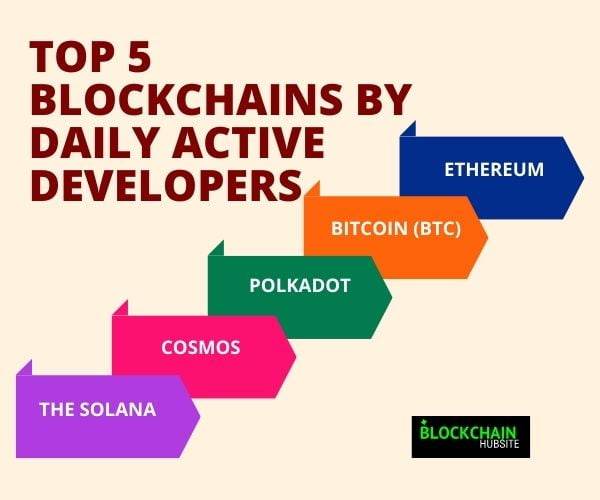
1. Ethereum
Ethereum, the pioneering blockchain platform for decentralized apps (dApps) and smart contracts, is the most popular blockchain among daily active developers. As of June 2023, more than 5,900 active developers were on Ethereum, and 1,900 full-time developers were also contributing to the ecosystem.
This sizable development community is evidence of Ethereum’s supremacy and the steadfast support it receives from researchers, developers, and enthusiasts. Thanks to its strong and constantly improving infrastructure, the platform can support innovative decentralized application (dApp) protocols, smart contract deployment, and decentralized finance (DeFi).
Ethereum’s ecosystem, which encourages teamwork, knowledge sharing, and constant improvement, makes it even more of a top choice for developers. A wide variety of contributors, each with their distinct viewpoint and area of expertise, have been drawn to the platform because of its open-source nature and dedication to decentralization.
Additionally, the much-anticipated Ethereum 2.0 upgrade is just one example of how Ethereum works to improve the network’s scalability and interoperability to remove its present restrictions, allowing for broader adoption and more sophisticated use cases. The platform’s capacity to adjust to evolving requirements and participate in continuous development has contributed to its long-term appeal to developers.
2. Bitcoin (BTC)
Bitcoin, the first cryptocurrency and the inspiration for decentralized digital currencies has become an influential player in the blockchain industry. Bitcoin has a large developer community committed to its ongoing improvement despite its primary focus on being a decentralized, transparent, and unchangeable medium of trade and store of wealth.
As of June 2023, more than 322 full-time and 960 monthly active developers are responsible for Bitcoin’s development. This large community of contributors is working to improve the Bitcoin network’s scalability, privacy, security, and usability.
Resolving the network’s scalability issues is one of Bitcoin’s developers’ top concerns. The demand for faster and more affordable transactions drives the development and implementation of creative solutions like the Lightning Network and other layer-two scaling ideas.
Another critical area of concern for Bitcoin developers is privacy. The network’s privacy features are being improved to ensure users can transact while keeping their anonymity as the value of financial privacy continues to grow.
The developers of Bitcoin are always on the lookout for new security flaws since this is a cornerstone of the cryptocurrency’s success. Regular code audits, rigorous testing, and cutting-edge cryptographic algorithms keep the network resilient to potential assaults and threats.
Additionally, Bitcoin’s developers aim to improve the cryptocurrency’s usability so that new and experienced users can find it easier to use. This involves looking for new use cases to increase Bitcoin’s adoption and practical uses, making onboarding more accessible, and enhancing wallet interfaces.
Even though Bitcoin was the first and most well-known cryptocurrency, it is still being developed by a passionate and committed group of developers. Their constant commitment to enhancing the network’s scalability, privacy, security, and usability guarantees that Bitcoin will remain a dominant player in the dynamic blockchain industry.
3. Polkadot
Polkadot is a highly influential multi-chain network that aims to facilitate scalability and interoperability among different blockchains. As of June 2023, Polkadot’s dedication to innovation and growth is evident in its community of over 1,900 monthly active developers and a core staff of 645 full-time workers.
Polkadot functions primarily via a unique design of parallel chains called parachains and a central relay chain. This novel architecture promotes an atmosphere of cooperation and synergy by enabling the development of application-specific blockchains that can interact and exchange data.
An essential asset of Polkadot is its consistent emphasis on community-driven growth and good governance. The network can easily adjust to new trends and requirements because the platform has an update mechanism built in. Furthermore, Polkadot’s treasury system allows for the financing of community-driven projects, encouraging a thriving ecosystem of experimentation and innovation.
Polkadot’s use of several scaling techniques, including sharding and parallelization, demonstrates the company’s commitment to scalability. Polkadot seeks to solve a significant problem with conventional blockchain networks by spreading computing duties among numerous parachains, which should allow for exceptional transaction performance.
Additionally, Polkadot is revolutionizing the blockchain business with its focus on interoperability. By facilitating asset movement and seamless communication across different blockchain networks, Polkadot unlocks new horizons of decentralized innovation and paves the way for cross-chain apps and collaborative ecosystems.
Polkadot is a leader in the multi-chain world thanks to its strong developer community, control systems, and unwavering dedication to scalability and interoperability. Its influence goes beyond its immediate environment because it sets the stage for a future in which different blockchain networks can collaborate, share resources, and accelerate the spread of decentralized technology.
4. Cosmos
Cosmos is a trailblazing multi-chain network making waves in the race for heterogeneous blockchains to be scalable and interoperable. Cosmos is strongly committed to encouraging innovation and cooperation across the blockchain ecosystem, as seen by its devoted team of 524 full-time developers and an exceptional community of over 1,600 monthly active developers as of June 2023.
Cosmos’s distinctive architectural style is based on “zones,” or autonomous blockchains interconnected via a central hub. This novel method permits the presence and interaction of various blockchain networks, including distinct traits, consensus procedures, and governance models.
An impressive element of Cosmos is the Cosmos Software Development Kit (SDK), which allows developers to build their blockchains using modular parts. This modular architecture can unlock a new realm of opportunities and use cases, establishing an “internet of blockchains,” in which separate blockchain networks can communicate, share data, and permit the movement of assets across chains.
Two of the many scaling options Cosmos has used are sharding and parallelization. By spreading computational duties across numerous zones, Cosmos intends to solve the scalability issues that have long affected conventional blockchain networks, achieving remarkable transaction throughput.
The blockchain industry is also witnessing a paradigm shift because of Cosmos’s focus on interoperability. Cosmos facilitates the smooth exchange of assets and communication between multiple blockchain networks, fostering a dynamic and linked decentralized ecosystem. This offers a multitude of opportunities for cross-chain applications and collaborative ecosystems.
Cosmos is well-positioned to be a significant player in the multi-chain space thanks to its committed development community, solid architectural design, and continuous dedication to scalability and interoperability. Because it lays the groundwork for future blockchain networks to coexist, interact, and push the adoption of decentralized technology across multiple industries and use cases, its significance goes beyond its ecosystem.
5. Solana
With its fresh approach to solving the age-old problems of scalability, speed, and security, the high-performance blockchain network Solana has quickly become a favorite among cryptocurrency enthusiasts. As of June 2023, Solana has a workforce of 363 full-time developers and a community of over 1,400 monthly active developers. As such, Solana is committed to pushing innovation and adoption.
The distinctive Proof-of-History (PoH) consensus method is central to the Solana architecture; it uses a cryptographic clock to facilitate secure, scalable, and quick transactions. This new solution allows Solana to accomplish outstanding throughput and low latency. It streamlines the validation process by eliminating the need for standard time-stamping approaches.
Data compression, pipelining, and parallel processing are a few more ways Solana demonstrates its dedication to scalability. Because these features allow for effective resource utilization, Solana can process unprecedented transactions per second with minimal energy usage and low transaction fees.
One of Solana’s most vital points is its adaptability and use in several fields. Decentralized finance (DeFi) applications can take advantage of its high-performance features, which allow for safe and quick financial transactions. If you’re looking for a platform that can handle real-time interactions and smooth asset transfers, go as far as Solana. It’s scalable, has low latency, and is perfect for gaming and NFT platforms.
In addition, the Web3 landscape has grown thanks to Solana’s dedication to cultivating a thriving ecosystem, which has drawn various developers and initiatives. Solana enables developers to construct and explore new frontiers in decentralized technologies by providing a solid and efficient infrastructure. Developers can then design novel decentralized apps (dApps).
Thanks to its novel consensus mechanism, enhanced scalability, and vibrant development community, Solana is growing into a significant force in the blockchain space. It affects more than just its ecosystem. It opens the way for a future where decentralized apps can work with the best performance, security, and user experience. This will make blockchain technology widely used in many fields and situations.

